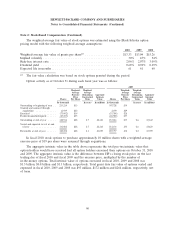HP 2010 Annual Report Download - page 92
Download and view the complete annual report
Please find page 92 of the 2010 HP annual report below. You can navigate through the pages in the report by either clicking on the pages listed below, or by using the keyword search tool below to find specific information within the annual report.HEWLETT-PACKARD COMPANY AND SUBSIDIARIES
Notes to Consolidated Financial Statements (Continued)
Note 1: Summary of Significant Accounting Policies (Continued)
Business Combinations
HP has adopted the new accounting standard related to business combinations. HP has included
the results of operations of the businesses that it acquired in fiscal 2010 in HP’s consolidated results as
of the respective dates of acquisition. HP allocates the purchase price of its acquisitions to the tangible
assets, liabilities and intangible assets acquired, including in-process research and development
(‘‘IPR&D’’), based on their estimated fair values. The excess of the purchase price over those fair
values is recorded as goodwill. IPR&D is initially capitalized at fair value as an intangible asset with an
indefinite life and assessed for impairment thereafter. When the IPR&D project is complete, it is
reclassified as an amortizable purchased intangible asset and is amortized over its estimated useful life.
If an IPR&D project is abandoned, HP will record a charge for the value of the related intangible asset
to HP’s Consolidated Statement of Earnings in the period it is abandoned. Acquisition-related expenses
and restructuring costs are recognized separately from the business combination and are expensed as
incurred.
Goodwill and Purchased Intangible Assets
Goodwill and purchased intangible assets with indefinite useful lives are not amortized but are
tested for impairment at least annually. HP reviews goodwill and purchased intangible assets with
indefinite lives for impairment annually at the beginning of its fourth fiscal quarter and whenever
events or changes in circumstances indicate the carrying value of an asset may not be recoverable. For
goodwill, HP performs a two-step impairment test. In the first step, HP compares the fair value of each
reporting unit to its carrying value. In general, HP’s reporting units are consistent with the reportable
segments identified in Note 19. However, for certain businesses within the Corporate Investments
segment, the reporting unit is one step below the segment level. HP determines the fair value of its
reporting units based on a weighting of income and market approaches. Under the income approach,
HP calculates the fair value of a reporting unit based on the present value of estimated future cash
flows. Under the market approach, HP estimates the fair value based on market multiples of revenue
or earnings for comparable companies. If the fair value of the reporting unit exceeds the carrying value
of the net assets assigned to that unit, goodwill is not impaired and no further testing is performed. If
the carrying value of the net assets assigned to the reporting unit exceeds the fair value of the
reporting unit, then HP must perform the second step of the impairment test in order to determine the
implied fair value of the reporting unit’s goodwill. If the carrying value of a reporting unit’s goodwill
exceeds its implied fair value, HP records an impairment loss equal to the difference.
HP estimates the fair value of indefinite-lived purchased intangible assets using an income
approach. HP recognizes an impairment loss when the estimated fair value of the indefinite-lived
purchased intangible assets is less than the carrying value.
HP amortizes purchased intangible assets with finite lives using the straight-line method over the
estimated economic lives of the assets, ranging from one to ten years.
Long-Lived Asset Impairment
HP evaluates property, plant and equipment and purchased intangible assets with finite lives for
impairment whenever events or changes in circumstances indicate the carrying value of an asset may
not be recoverable. HP assesses the recoverability of the assets based on the undiscounted future cash
flow and recognizes an impairment loss when the estimated undiscounted future cash flow expected to
84
























